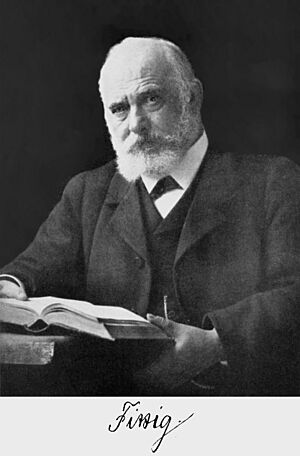Wilhelm Rudolph Fittig facts for kids
Quick facts for kids
Wilhelm Rudolph Fittig
|
|
|---|---|
 |
|
| Born | 6 December 1835 |
| Died | 19 November 1910 (aged 74) |
| Alma mater | University of Göttingen |
| Known for | Fittig reaction Lactone Pinacol rearrangement |
| Awards | Davy Medal (1906) |
| Scientific career | |
| Fields | Chemistry |
| Institutions | University of Göttingen |
| Doctoral advisor | Heinrich Limpricht and Friedrich Wöhler |
| Doctoral students | Ira Remsen |
Wilhelm Rudolph Fittig (born December 6, 1835, died November 19, 1910) was an important German chemist. He made many discoveries that helped us understand how chemicals work. For example, he found the pinacol coupling reaction, which is a way to join two molecules together.
Fittig also discovered several chemical compounds. These include mesitylene, diacetyl, and biphenyl. He studied how sodium reacts with other chemicals like ketones and hydrocarbons. He also developed the Fittig reaction, or Wurtz–Fittig reaction. This reaction is used to create special types of hydrocarbons called alkylbenzenes.
Fittig also worked on understanding the structure of benzoquinone. He was the first to find phenanthrene in coal tar. He discovered and created the first lactones, which are a type of organic compound. He also researched the structures of other important chemicals like piperine, naphthalene, and fluorene.
Contents
Fittig's Journey in Chemistry
Fittig began his chemistry studies at the University of Göttingen. He earned his Ph.D. in 1858. His main project was about a chemical called acetone. His teachers were Heinrich Limpricht and Friedrich Wöhler.
After graduating, Fittig stayed at Göttingen. He became Wöhler's assistant in 1858. Later, he became a private lecturer in 1860. By 1870, he was an extraordinary professor. In 1870, he became a full professor at the University of Tübingen. Then, in 1876, he moved to Strassburg. He even helped design the chemistry labs there.
Key Discoveries and Research
Fittig's research covered many areas of organic chemistry. His early work focused on aldehydes and ketones. He noticed that these chemicals could change into other substances. These new substances were called pinacones.
He also found that if you heated certain pinacones with sulfuric acid, they would turn into pinacolines. Fittig also discovered the pinacol rearrangement. This is a process where one type of alcohol changes into an aldehyde or ketone.
Fittig also spent a lot of time studying unsaturated acids. He discovered lactones, which are a special type of internal anhydride.
The Wurtz-Fittig Reaction
In 1855, another chemist, Charles-Adolphe Wurtz, found a way to combine chemicals using sodium. Fittig took this idea and made it even better. He showed that you could mix two different types of chemicals, an aryl halide and an alkyl halide. When treated with sodium, these would combine to form larger hydrocarbons. This important process is now known as the Wurtz-Fittig reaction.
Understanding Complex Molecules
Fittig also helped explain how the Perkin reaction works. This reaction is used to create certain organic compounds. His work helped solve the structure of coumarin. Coumarin is the chemical that gives woodruff its sweet smell.
Fittig and his colleague Hugo Erdmann made another important discovery. They found that a chemical similar to isocrotonic acid could easily turn into α-naphthol. This discovery was very important for understanding the structure of naphthalene. They also studied chemicals found in coal tar. They figured out the structure of phenanthrene.
Fittig also contributed a lot to our knowledge of the chemical piperine. In 1871, he worked with Ira Remsen to figure out its structure.
Books and Recognition
Wilhelm Fittig wrote two widely used textbooks. He also helped edit many editions of Wöhler's Grundriss der organischen Chemie. He wrote his own book called Unorganische Chemie. Many scientific groups recognized his important research. The Royal Society gave him the Davy Medal in 1906 for his contributions to chemistry.
See also
- 2,5-Furandicarboxylic acid
- Durene
- Pinacol coupling reaction

